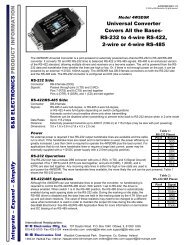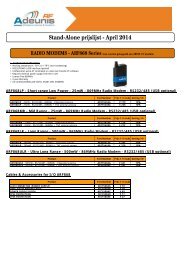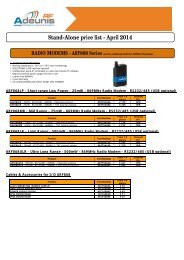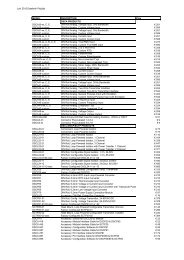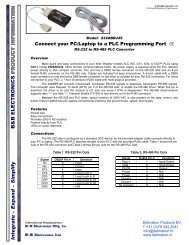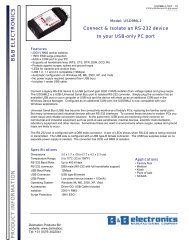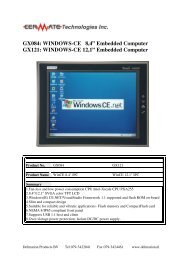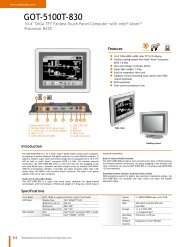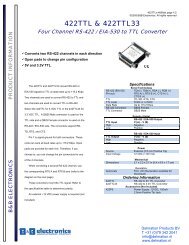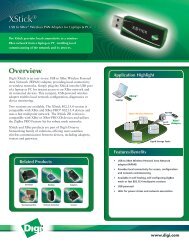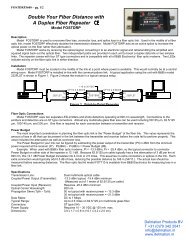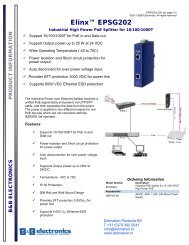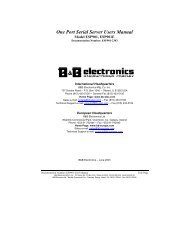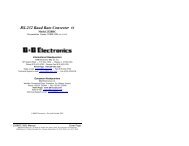RS-232 to RS-422 Self-Powered Converter - Delmation
RS-232 to RS-422 Self-Powered Converter - Delmation
RS-232 to RS-422 Self-Powered Converter - Delmation
- No tags were found...
You also want an ePaper? Increase the reach of your titles
YUMPU automatically turns print PDFs into web optimized ePapers that Google loves.
Integrate – Expand – Simplify B&B ELECTRONICS PRODUCT INFORMATIONInternational Headquarters:<strong>422</strong>LPCOR-3903-1/2© 2003 by B&B Electronics. All rights reserved.Model <strong>422</strong>LPCOR<strong>RS</strong>-<strong>232</strong> <strong>to</strong> <strong>RS</strong>-<strong>422</strong> <strong>Self</strong>-<strong>Powered</strong> <strong>Converter</strong> CEThis <strong>RS</strong>-<strong>232</strong> <strong>to</strong> <strong>RS</strong>-<strong>422</strong> converter converts unbalanced <strong>RS</strong>-<strong>232</strong> signals <strong>to</strong> balanced <strong>RS</strong>-<strong>422</strong> signals. The power usedfor this converter is derived from the transmit data line (pin 2) and the handshake control lines (pins 4, 5, 6, 8, and 20).The converter can derive power from these lines when they are in the positive or negative voltage state. This permitsthe converter <strong>to</strong> be used in applications without any regard <strong>to</strong> software control of the handshake lines. If no handshakelines are available and all power must be derived from the transmit data line, the converter can drive limited cablelengths. A guide for this condition would be <strong>to</strong> drive only several hundred feet of transmission line and not <strong>to</strong> terminatethe transmission line with a resis<strong>to</strong>r of less than 1000 ohms. When more handshake lines are available, longer lengthsof cable can be driven. This converter has been tested at 115.2k baud with 4000 feet of cable. For applications wherehandshake lines are not available and long cable runs are involved, an external power supply can be connected <strong>to</strong> theterminal blocks on the <strong>RS</strong>-<strong>422</strong> side of the converter marked "+12V" and "GND".NOTE: When using an external supply, the supply should be connected only <strong>to</strong> specifically labeled powerinputs (power jack, terminal block, etc.). Connecting an external power supply <strong>to</strong> the handshake lines maydamage the unit. Contact technical support for more information on connecting an external power supply <strong>to</strong>the handshake lines.The <strong>RS</strong>-<strong>232</strong> port uses a female DB25 type of connec<strong>to</strong>r with pins 2 (TD input) and 3 (RD output) supported. SignalGround (pin 7) is connected through <strong>to</strong> the <strong>RS</strong>-<strong>422</strong> side on the terminal block marked "GND".Interconnection of the converter with another <strong>RS</strong>-<strong>422</strong> device:1. The polarity of the two <strong>RS</strong>-<strong>422</strong> lines must be correct. With no data being sent, the <strong>RS</strong>-<strong>232</strong> line should be negativeand the <strong>RS</strong>-<strong>422</strong> "A" terminal should be negative with respect <strong>to</strong> the "B" terminal.2. The wire recommended in the <strong>RS</strong>-<strong>422</strong> Standard is number 24 AWG copper conduc<strong>to</strong>r, twisted-pair telephonecable with a shunt capacitance of 16 pF per foot.3. For long runs and/or high data rates it is recommended that the wires be terminated with a resis<strong>to</strong>r at the receiveend. The twisted pair usually used has an impedance of about 100 Ohms, therefore a 100 ohm resis<strong>to</strong>r is normallyused for the termination. The <strong>RS</strong>-<strong>422</strong> side of the converter requires more power as the transmission line is increasedand as the termination resis<strong>to</strong>r value is reduced, therefore it may be necessary <strong>to</strong> use a termination resis<strong>to</strong>r that islarger than 100 ohms.4. The <strong>RS</strong>-<strong>422</strong> driver has the ability <strong>to</strong> drive 10 <strong>RS</strong>-<strong>422</strong> receivers connected in parallel. A system of multiple receiversmay require some experimentation with location and size of termination resis<strong>to</strong>rs, line lengths, grounding, etc.DECLARATION OF CONFORMITYManufacturer’s Name:B&B Electronics Manufacturing CompanyManufacturer’s Address: P.O. Box 1040707 Day<strong>to</strong>n RoadOttawa, IL 61350 USAModel Numbers:<strong>422</strong>LPCORDescription:<strong>RS</strong>-<strong>422</strong> 2-Channel Port-<strong>Powered</strong> <strong>Converter</strong>Type:Light industrial ITE equipmentApplication of Council Directive: 89/336/EECStandards: EN 55022EN 61000-6-1EN 61000 (-4-2, -4-3, -4-4, -4-5, -4-6, -4-8, -4-11)William H. Franklin III, Direc<strong>to</strong>r of Engineering<strong>Delmation</strong> Products BVT +31 (0)79 342 2041info@delmation.nlwww.delmation.nl
Integrate – Expand – Simplify B&B ELECTRONICS PRODUCT INFORMATIONInternational Headquarters:<strong>422</strong>LPCOR-3903-2/2© 2003 by B&B Electronics. All rights reserved.<strong>Delmation</strong> Products BVT +31 (0)79 342 2041info@delmation.nlwww.delmation.nl



